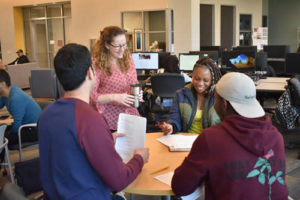As educators, we develop lesson plans with careful consideration and effort. When one works, we fall in love, hesitant to change it too much for fear that change might bring less student success.
The old adage: If something works, why change it? There is a simple answer: the willingness to exit our comfort zone, to embrace new ideas, and to change our teaching results in increased student performance and engagement.
A framework for innovative teaching
If we are lucky, something triggers us to question our routines and habits, and this sets us on an unexpected trajectory. For me, that moment came in August 2018 when I became part of the Teaching and Innovation Fellows program through the West Houston Institute at Houston Community College.
The Teaching and Innovation Fellows program brings together a cross-section of college instructors and administrators, united in their interest in innovative thinking and how it applies to their respective roles.
The year-long fellowship began with a curriculum developed by EdgeMakers, an organization that teaches students and teachers to be innovative and entrepreneurial. EdgeMakers believes everyone has the capacity to be creative and innovative, and the curriculum provides a framework for innovative thinking regarding complex challenges.
Related: 5 terrific edtech tools for creating a highly engaging online (or hybrid) course
In the beginning of the fellowship, our facilitator asked us to read, write, and reflect on themes surrounding innovation and creativity. As an English teacher, I’d already seen much of what was presented—brainstorming, storyboards, journaling—and it seemed like busy work. As we continued, my thinking morphed, and I began processing connections between concepts and ideas differently.
The turning point
In the fourth week, the cohort engaged in a real-time interactive discussion that forced me to recognize a sobering thought: My class, the one I was so proud of, was boring and unengaging. I went home and abruptly changed my next unit, determined to recreate the innovative experience the curriculum articulated, that creativity is within everyone.
As a result, I shifted my classroom to a flexible learning model that allowed my students to lead their own learning, to have the option to work productively in groups, and to cross disciplines. Rather than relying on teacher-led instruction, students experienced a flexible environment and felt the same engagement I experienced in my fellowship program.
Lesson makeovers
I took a fresh approach to my old poetry project. Instead of assigning a paper that I controlled and guided, groups now present all the same content using Adobe Spark, One Button Studio, or both. Initially, students were hesitant, not unlike my experience with EdgeMakers; after a few classes, however, they fully embraced this method of learning. They found that, while challenging, incorporating technology into learning was not only fun but stimulating. Students learned about poetry while acquiring new digital-literacy skills.
The inverse relationship between my control and their engagement became evident almost immediately. As I relinquished control, students took ownership of their learning. It was scary at first, but composition class is more than writing a five-page paper. Composition is about communicating in multiple contexts and making connections between things that seemingly don’t relate.
Integrated multimedia allowed my students to express their interpretations of poetry in new and exciting ways. Most important, they were engaged in the material, often staying after class and returning to the Learning Commons to perfect their videos. The content of the projects was just as impressive as their embracing of new tech skills. It was evident they cared.
Improved outcomes
On this high note, I continued revising the class in real time and added 3D printing to the critical analysis paper. Using the college’s IDEAStudio (makerspace), students made a lithophane representing the analysis. The lithophane process is simple: After drawing a picture symbolizing the story’s theme, the students take a photograph of it. Using 3D printing software, the students upload the photo and prepare the lithophane for printing. Simultaneously, students reflect on the themes, conduct research, and write an accompanying paper. On the last day of class, students provide an oral explanation of the lithophane.
Students stayed late the day before Thanksgiving to finish up their prints, and many came early on the following Monday to see their work product. Again, they cared. Their papers reflected a careful critical thinking of the work.
Related: 9 college presidents on increasing innovation on campus
Here are more tips I picked up from this experience.
- Let go of control. Don’t be afraid to relinquish control of your classroom. As you relinquish control, the students take control and ownership of their learning. This causes them to become more engaged.
- Break away from preconceived ideas. Reevaluate how you think you’re supposed to teach. Be willing to let go of rigid plans and adopt a more fluid approach.
- Facilitate—avoid lecture. Embrace the role of facilitator. Adopt different learning methods while encouraging students to gather and evaluate information from a variety of sources. As they do, guide them through critical analysis; help them create, collaborate, and communicate about all of it. Help them see connections they may not have seen.
- Embrace new technology. Students may be digital natives, but teachers play a role in helping them become digitally literate.
My training through EdgeMakers changed my perceptions of teaching and prompted me to surrender control, re-evaluate my teaching routine, and provide students with greater ownership of their learning. If our goal is to prepare students with the tools and skills to intelligently tackle complex challenges across disciplines, then teachers need to be open to innovative ideas that encourage engaged learning.
- Selective universities won’t be disrupted - April 30, 2024
- Fully Homomorphic Encryption can revolutionize education - April 29, 2024
- Survey: More students want to go to graduate school - April 24, 2024

